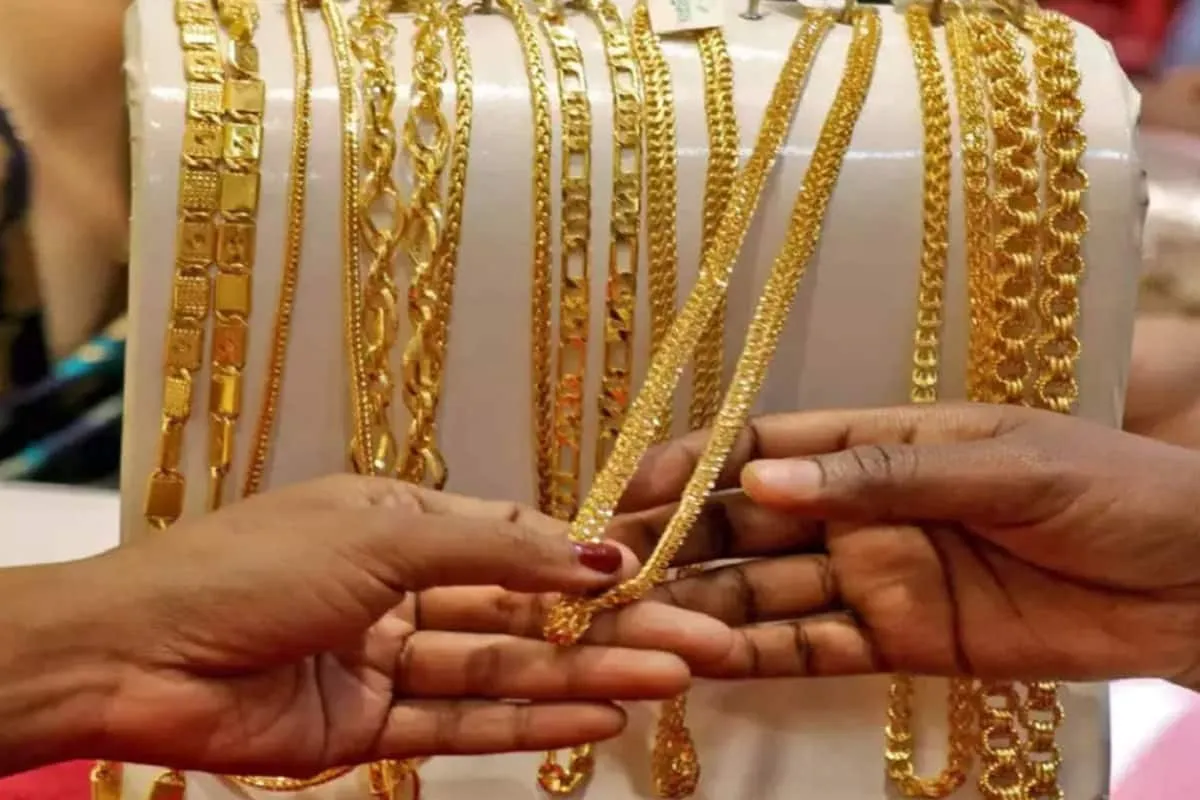Gold Rate Today: Record High Prices Shock Jewelry Lovers

Gold Rate Today: Record High Prices Shock Jewelry Lovers
The gold market in India has witnessed a dramatic surge, with prices reaching unprecedented highs as of September 2, 2025. On September 1, the price of 22-karat gold soared by Rs. 85 per gram, selling at Rs. 9,705 per gram, and by Rs. 680 per sovereign, reaching Rs. 77,640 per sovereign. Continuing this upward trend, on September 2, 22-karat gold increased by Rs. 20 per gram to Rs. 9,725 per gram and Rs. 160 per sovereign to Rs. 77,800 per sovereign. Similarly, 18-karat gold rose by Rs. 15 per gram to Rs. 8,045 per gram and Rs. 120 per sovereign to Rs. 64,360 per sovereign. Silver prices also climbed, with a Rs. 1 per gram increase, now selling at Rs. 137 per gram and Rs. 1,37,000 per kilogram. These record-breaking prices have left jewelry lovers and investors stunned, raising questions about whether gold will recover its momentum or face a correction in the coming weeks.
What’s Driving the Gold Price Surge?
The recent spike in gold prices can be attributed to a combination of global and domestic factors. Internationally, gold has been viewed as a safe-haven asset amid geopolitical tensions, including the ongoing Israel-Gaza conflict and trade uncertainties fueled by U.S. tariff policies. Expectations of a U.S. Federal Reserve rate cut in September 2025, currently priced at around 85%, have further bolstered gold’s appeal, as lower interest rates reduce the opportunity cost of holding non-yielding assets like gold. A weaker Indian rupee against the U.S. dollar has also driven up import costs, contributing to the domestic price surge, as India imports a significant portion of its gold.
Domestically, India’s cultural affinity for gold, especially during the festive and wedding seasons, has amplified demand. The period leading up to major festivals like Diwali typically sees a spike in jewelry purchases, pushing prices higher. Additionally, central bank purchases and increased investor interest in gold exchange-traded funds (ETFs) have sustained the bullish trend. According to market analysts, gold prices have risen by 13.99% over the past month, with the price per gram of 24-karat gold reaching Rs. 10,609 as of September 2, 2025, reflecting the strong demand and global economic uncertainties.

Impact on Jewelry Lovers and Consumers
The soaring gold prices have left jewelry lovers in a state of shock, particularly in India, where gold is not just an investment but a cultural symbol of prosperity and tradition. With 22-karat gold now priced at Rs. 9,725 per gram and 18-karat gold at Rs. 8,045 per gram, many consumers are reconsidering their purchase plans. The cost of a single sovereign (8 grams) of 22-karat gold at Rs. 77,800 is a significant financial commitment for middle-class families planning weddings or festive purchases. Jewelers across major cities like Chennai, Mumbai, and Delhi report a slowdown in retail demand, as buyers adopt a wait-and-see approach, hoping for a price correction.
The rise in silver prices, now at Rs. 137 per gram, has also affected consumers looking for more affordable alternatives to gold. Silver, often used in traditional jewelry and religious artifacts, has seen a record high in futures trading, crossing Rs. 1.24 lakh per kilogram. This dual surge in precious metals has strained household budgets, particularly during the festive season when demand for gold and silver ornaments peaks. Consumers are now exploring options like gold ETFs or Sovereign Gold Bonds (SGBs) to invest without the immediate burden of high physical gold prices.
Will Gold Prices Recover or Decline?
The question on everyone’s mind is whether gold prices will continue their upward trajectory or face a correction. Analysts offer mixed forecasts for the remainder of 2025. Optimistic projections suggest that gold could reach Rs. 269,798 per 10 grams by the end of the year, driven by persistent inflation, geopolitical risks, and central bank purchases. J.P. Morgan Research predicts an average price of $3,675 per ounce by Q4 2025, equivalent to approximately Rs. 11,000 per gram at current exchange rates, indicating further upside potential. However, some analysts warn of a possible decline if global economic conditions stabilize or if the U.S. dollar strengthens due to sustained high interest rates.
Short-term fluctuations are expected, with some experts predicting a consolidation phase in the next two to three weeks due to profit-taking following the recent rally. For instance, Praveen Singh from Sharekhan anticipates gold testing support levels at $2,700 per ounce, which could translate to a slight dip in domestic prices. Factors such as reduced demand during non-festive periods or changes in import duties could also contribute to a price correction. Nevertheless, gold’s long-term outlook remains bullish, as it continues to serve as a hedge against inflation and economic uncertainty.
Investment Options Amid Rising Prices
For investors and consumers navigating these record-high prices, alternative investment options are gaining traction. Sovereign Gold Bonds, offered by the Reserve Bank of India, provide a fixed interest rate and track gold prices without the need for physical storage. Gold ETFs, traded on stock exchanges, allow investors to benefit from price movements without purchasing physical gold. Gold mutual funds, which invest in gold ETFs and related assets, are another option for those seeking diversification. These alternatives are particularly appealing given the high cost of physical gold and the additional expenses of storage and insurance.
For those considering gold loans, the rising prices present an opportunity to secure higher loan amounts against their jewelry, as lenders offer better loan-to-value ratios when gold prices are high. However, experts recommend monitoring market trends closely and choosing lenders with transparent valuation and flexible repayment plans to mitigate risks from price volatility. The current gold rate forecast for September 2025, predicting a 4% increase to Rs. 114,036 per 10 grams, suggests that timing investments or loans strategically could maximize returns.
Global and Domestic Market Dynamics
Globally, gold prices are influenced by the London Bullion Market Association (LBMA) benchmarks, which set the tone for domestic pricing in India, one of the world’s largest gold importers. The spot gold price reached $3,493.91 per ounce on September 2, 2025, a 39.97% increase from the previous year, reflecting strong global demand. Central banks, including the Reserve Bank of India, have been actively purchasing gold to diversify reserves, with global holdings now exceeding U.S. Treasury holdings for the first time since 1996. This shift underscores gold’s role as a reserve asset during economic instability.
In India, the exchange rate between the Indian rupee and the U.S. dollar plays a critical role, as a weaker rupee increases import costs, pushing domestic prices higher. The rupee hit a record low against the dollar in September 2025, exacerbating the gold price surge. Additionally, India’s high import duties and taxes on gold further elevate costs for consumers. If the government reduces these duties to curb smuggling or improve trade balances, it could lead to a temporary decline in prices, offering relief to buyers.
What Lies Ahead for Gold Prices?
Looking ahead, the gold market is poised for continued volatility. Forecasts for October and November 2025 predict a 4-5.9% increase in gold prices, driven by global economic uncertainties and domestic demand during India’s festive season. However, a stronger U.S. dollar or improved global risk sentiment could temper this growth, potentially leading to a price correction. Investors are advised to monitor key indicators such as U.S. Federal Reserve policies, inflation rates, and geopolitical developments, which will shape gold’s trajectory in the coming months.
For jewelry lovers, the current high prices may delay purchases, but gold’s enduring value as a cultural and financial asset ensures its appeal. Whether investing in physical gold, ETFs, or bonds, staying informed about market trends and forecasts is crucial for making sound financial decisions in this dynamic landscape.
Comment / Reply From
No comments yet. Be the first to comment!











